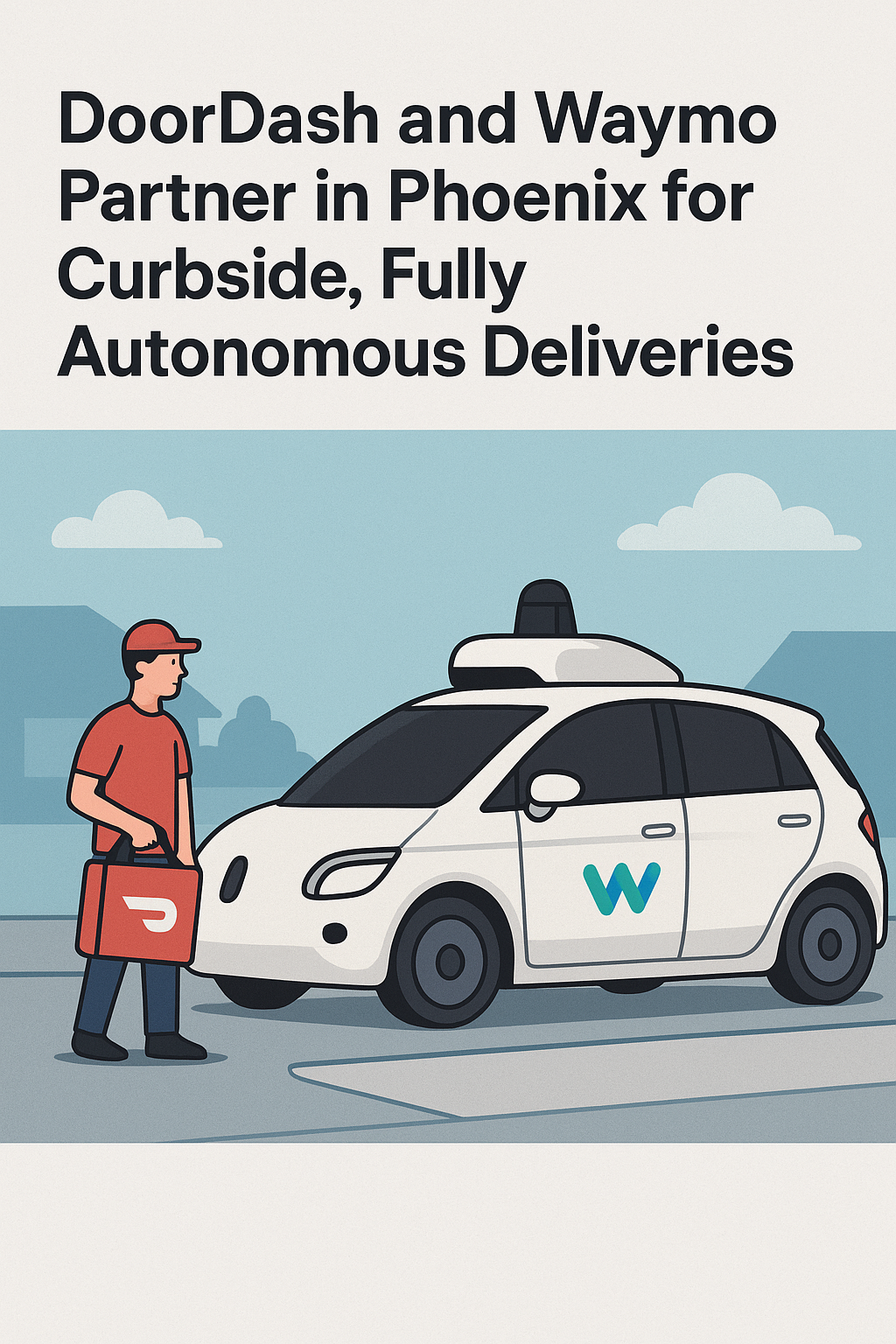
by Jason Tieri | Oct 26, 2025 | Blog
Download the audio of the show
Autonomous delivery is no longer a teaser headline; it is rolling onto real streets with real implications. DoorDash and Waymo’s partnership in Phoenix pushes the boundary from novelty to pilot-scale logistics. The draw is clear: fewer human errors, efficient routing, and the promise of cheaper last-mile costs for merchants. Yet the user experience shifts too. A car that doesn’t leave the curb means customers walk out to retrieve food, a small friction that could recalibrate expectations built by porch drop-offs. While DashPass perks try to sweeten adoption with credits for Waymo rides, the deeper question is how automation reshapes demand for human dashers and whether consumers accept a little inconvenience for consistency and perceived safety.
The episode also digs into Uber’s new tip guarantee for delivery orders. Tip baiting—adding a tip to get priority, then pulling it back after delivery—has been an emotional pain point for drivers. With guarantee badges, Uber says it will cover any post-delivery reduction while passing along increases. If implemented cleanly, this reduces income volatility and lets couriers make faster accept-or-decline decisions. Caveats remain: the guarantee doesn’t cover many third-party white-label orders, and it will roll out market by market. Still, seeing a locked payout number could lower cognitive load and extend session time because drivers spend less energy monitoring adjustments and disputing outcomes.
Not every headline is about code. We examine a viral claim from a Dasher deactivated after reporting a sexual assault, which unravelled into a very different story: a customer’s door marked “leave at door,” a slightly ajar entry, and a Dasher who stepped inside and filmed a passed-out resident. This raises core standards all platforms reiterate but workers sometimes overlook: do not enter homes, respect instructions, and do not record or post private individuals. The internet never forgets, and violations flip the script from victim to liable party. The takeaways are pragmatic: confirm drop-off spots, default to no-contact protocols, and if anything feels off, retreat and document via the app rather than social media.
We also zoom out on safety through two Amazon clips: large drones crashing in neighborhoods and a driver wading through floodwaters to deliver. The drones underscore that early-stage hardware fails, and when aircraft the size of a small garbage can fall, public trust dips fast. The flood footage shows grit, but it also risks injury, contamination, and lost packages. The professional move is to escalate conditions, request a return, and follow carrier guidelines. A separate door-mirror incident with a delivery worker walking away after breaking it reinforces a universal rule: own the mistake immediately. Most customers respond far better to honesty and a clear path to remediation than to silence captured by a Ring camera.
On the rideshare side, Uber’s rider-rating filters and three-way chat for teen and family profiles show a platform leaning into control and transparency. Drivers can set minimum rider ratings, potentially reducing confrontations or risky pickups, while parents can join a group chat to confirm details and curb teen antics. Neither feature is a silver bullet; strict thresholds may reduce request flow and leave low-rated riders stranded. But as optional tools, they shift more agency to drivers and guardians. Combined with small income boosters like Octopus in-car tablets for trivia and tips, the app ecosystem nudges toward safer, clearer, and slightly better-paid sessions—provided drivers deploy the tools thoughtfully and avoid the pitfalls that keep going viral for all the wrong reasons.
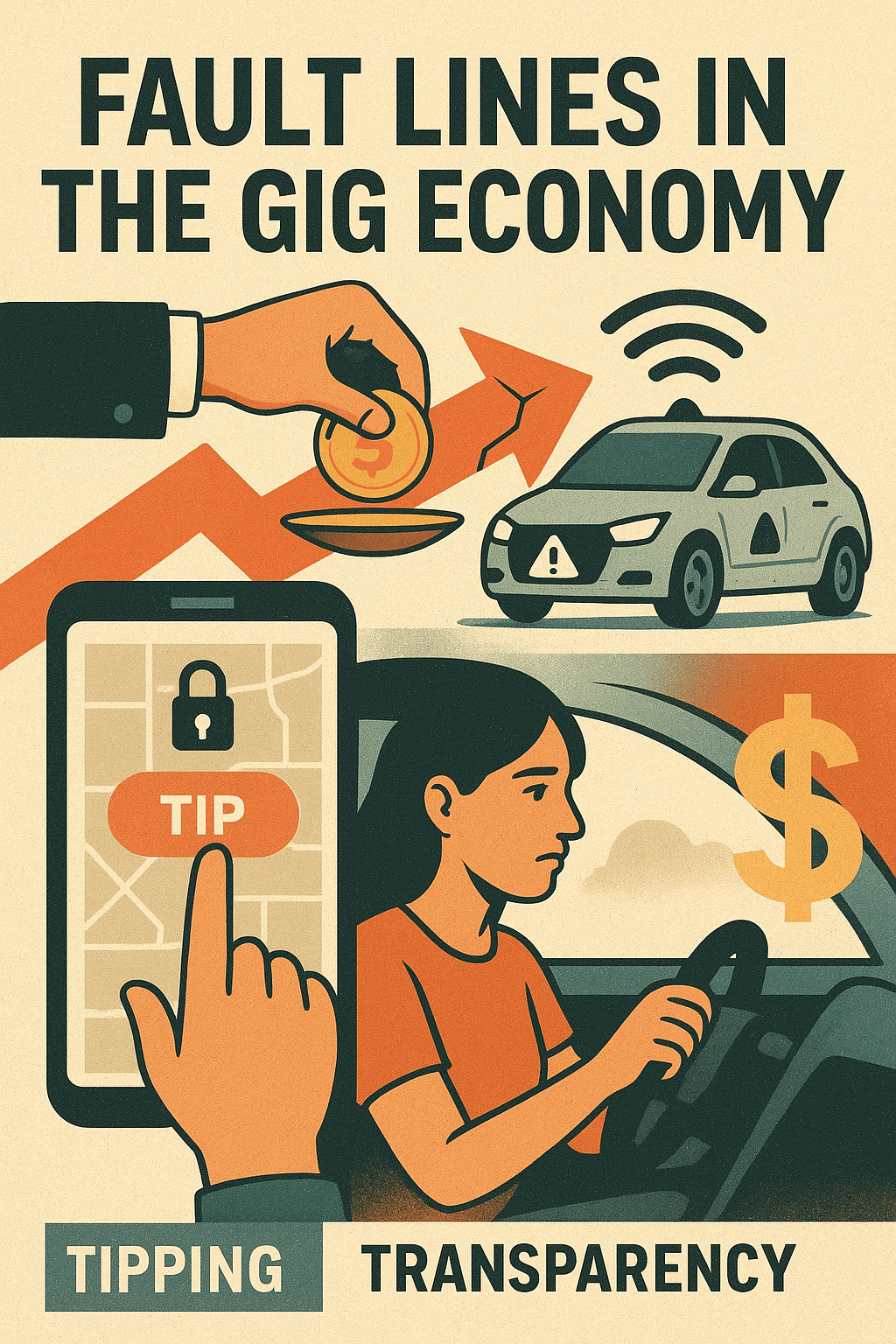
by Jason Tieri | Oct 20, 2025 | Blog
The gig economy is moving fast, and the fault lines are easy to see: tipping, transparency, automation, and the reality of driver pay. We kicked off by talking community—Patreon, live streams, and a Telegram group where drivers swap real-time tips and vent without feeling alone. That context matters, because the news this week landed squarely on driver livelihoods. Lyft tested a banner that showed drivers how often a rider tips and whether they’re usually ready at pickup. For drivers, that’s gold: another data point to decide which requests to accept. For riders, it felt like a scarlet letter. The result was predictable—viral backlash and a quick rollback. The episode framed the core tension: drivers need transparency to earn; platforms worry about PR and rider churn.
We unpacked tipping culture and its generational divide. Survey data shows many Americans think tipping has spun out of control, yet a large share still tips drivers—though Gen Z lags. That tracks with on-the-ground stories at ballparks and in rideshare. The tricky part is context: restaurant servers don’t bring their own tools; drivers do. Personal vehicles, insurance, fuel, tires, and time all come from the driver side, meaning base pay without tips often fails to cover costs, especially on absurd pings like $5 for 21 miles over nearly 40 minutes. Transparency could help filter out bad requests, but any hint that a rider is labeled “non-tipper” gets framed as shaming. It raises a bigger question: should apps build for sustainable driver earnings or keep riders comfortable enough to keep booking?
Automation loomed large: Waymo fleets, pranksters calling 50 cars to a dead-end, and a viral clip of a Waymo making a sharp lane change. We explored whether the maneuver was aggressive code or a quick calculation to avoid blocking a turn. More broadly, we asked how autonomy should behave in human swarms—timid cars get boxed out; aggressive ones spark outrage. Then came a different kind of robot: Miami’s pilot of an AI-enabled police SUV that patrols, scans plates, and sends alerts. It’s pitched as a force multiplier, not a replacement, but it triggers familiar privacy debates. Still, compared to fixed camera networks, a mobile, visible deterrent may free officers to focus on human calls while catching patterns software detects better than a tired patrol.
Not all tech makes work easier, though. A delivery video showed a weightless envelope caught by wind; another showed a new Amazon driver collapsing a stone bench, with the homeowner rushing to help. Those moments remind us there are people behind the pings, trying to hit quotas while staying human. Heat maps and surge visuals can help, but drivers still juggle safety, speed, and customer expectations. The episode weighed a more radical future: Lyft’s partnership with Tensor on a personal robocar that owners can deploy on the platform, maintained by a fleet service. It’s a vision where your car doesn’t sit idle; it earns while you work. The snags are obvious—costs, regulations, liability, and real net income after cleaning, charging, and wear. But the direction is clear: more automation, more data, and new ways to monetize mobility.
We closed on the real takeaway: drivers need better tools, clearer pay, and community to stay sane. Riders need simple, fair expectations. Platforms need to stop testing features in ways that pit both sides against each other. If autonomy is coming, it should complement workers rather than erase them overnight. Until then, transparency on offers, honest ETAs, and fewer traps like 20-mile $5 runs would do more for trust than any shiny pilot. The gig economy is a living system; when one piece gets ignored—driver earnings, rider clarity, or platform policies—the whole thing groans. The fixes aren’t magic, but they’re not mysterious: pay fairly, show the numbers, and let adults choose the work that makes sense.
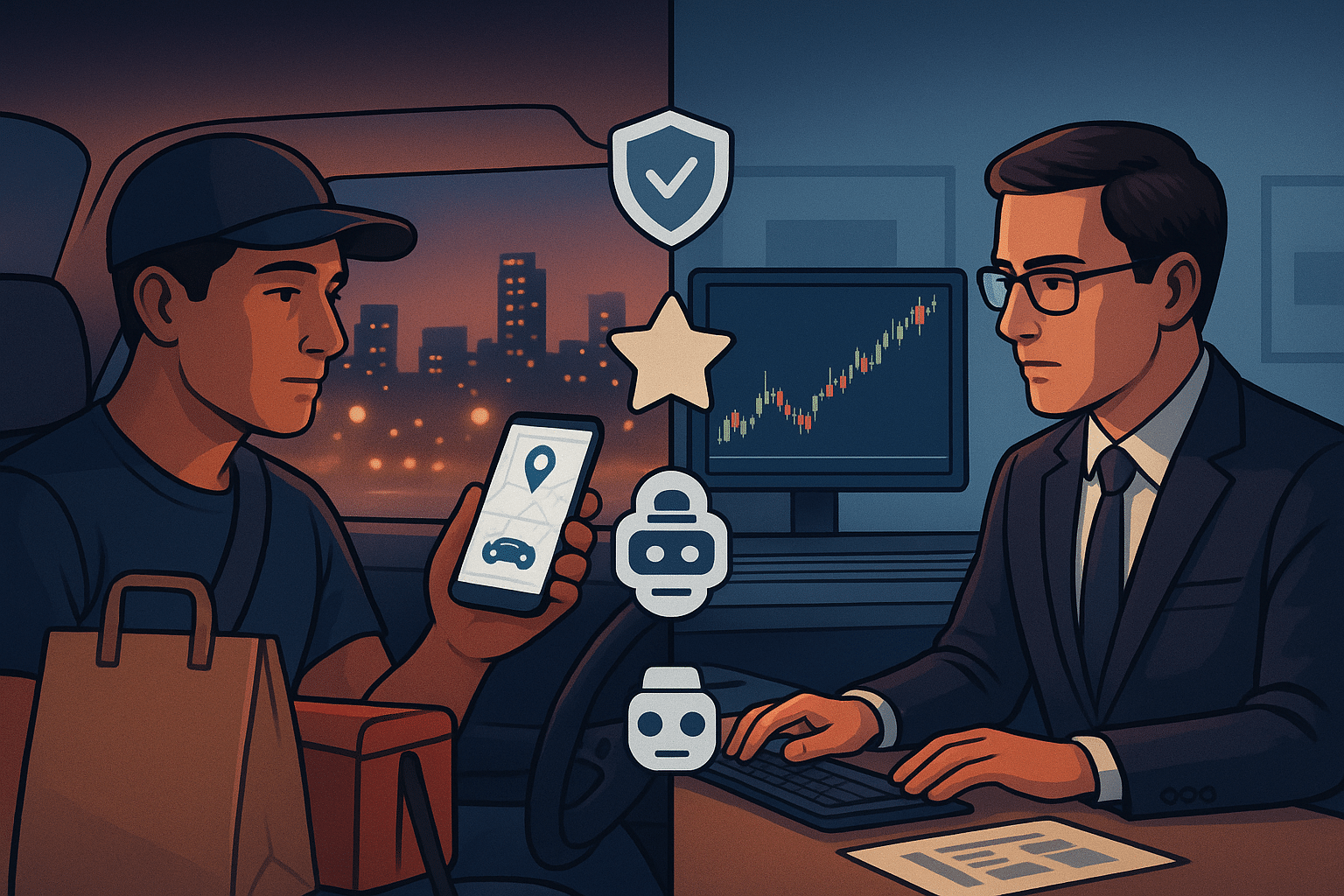
by Jason Tieri | Oct 12, 2025 | Blog
Download the show!
The latest wave of gig economy news reveals a tension every driver and savvy rider can feel: platforms race to automate, regulators and courts test accountability, and workers sift through new features hoping for reliability and better pay. We open with a listener’s story that reframes who tunes into gig conversations. Anna, a Wall Street professional, listens weekly not as a driver but as an analyst who values the driver lens when evaluating gig company investments. That single note captures the dual audience of today’s gig economy: people doing the work on the road, and people steering capital from the boardroom. When driver complaints filter back to Uber’s management, it reminds us that feedback loops can travel farther than we think. Strong communities—Patreon supporters, Telegram groups, and regulars who share clips—create ground truth you won’t find in earnings calls. These forums surface the small frictions and the big policy changes that shape pay, safety, and loyalty, and they often predict what headlines will notice months later.
On the road, experience still trumps theory. Fall breaks shift rider demand out of downtown cores and into suburbs. Family weekends and local events swing the pendulum between back-to-back requests and dead zones. Drivers weigh the time value of money with a hard floor—say $25 per hour—for Amazon routes that too often float closer to $21. A few years ago, those numbers might have been fine; today, with higher fuel, tires, and insurance, thresholds rise. Walmart Spark appeals because the miles are shorter, the density is higher, and the math can win even at slightly lower hourly averages. Meanwhile, sales moments—Prime Day, “deal” betas that dangle penny items—nudge behavior but don’t guarantee more driver hours tomorrow. Logistics lag, and real spikes show up days later in warehouses and last-mile dispatch. The lesson for workers is part strategy, part patience: set your rate, watch surges, and keep optionality across apps so you can pivot when one channel goes soft.
DoorDash’s new “favorite your shopper” feature could be the most meaningful consumer-side update in years for delivery pros. Loyalty in grocery or retail delivery compounds: a shopper learns preferences, substitutes wisely, and anticipates pitfalls at checkout. Customers gain trust, and good shoppers earn repeats without begging for off-app contact. Shipt has long leaned on relationships, but DoorDash scaling this across its ecosystem changes norms. If Uber or Lyft implemented a similar system beyond reservations—complete with distance caps and driver-set parameters to avoid $3 short hops across town—riders would enjoy consistency and drivers would finally harvest the value of great service inside the app. That would reduce the messy backchanneling of phone numbers and DMs that make scheduling clunky, put drivers at risk of no-shows, and complicate on-shift routing. Loyalty is powerful; when platforms align it with safety and transparency, everyone wins.
Safety, though, remains the hard edge of gig work. A recent jury found Uber negligent in safety measures but not liable for a driver’s alleged assault, a verdict that both acknowledges shortcomings and limits accountability. It’s a reminder that background checks—fingerprints or not—can’t predict first offenses, and policy is only as useful as reporting flows. When victims can’t easily find the right menu item to alert support, the system fails. That’s why drivers push for a prominent, persistent safety button, clearer post-ride reporting, and faster handoffs to law enforcement when urgency demands it. Public channels like Twitter (or X) still provoke the fastest responses, which says too much about internal escalation. Uber cites a 44% drop in serious sexual assault reports since 2017-2018, which may reflect genuine gains, shifting definitions, or underreporting; likely, it’s a mix. Real progress will be measured by time-to-response, transparency in outcomes, and the ease with which a rider or driver can trigger help without fear that their report will put a target on their back later.
Airports surfaced a different kind of accountability—operational discipline. In the UK, Uber is blocking airport trips for drivers with high cancellation rates for up to four weeks. It’s not about acceptance rate; it’s about accepting then backing out. Riders report chains of near-arrivals that evaporate just before pickup, a practice that lowers trust and traps travelers under time pressure. Given today’s payouts, many drivers already skip airports because the fares don’t justify dwell time and staging; blunt punishments may curb abuse but won’t fix misaligned incentives. Transparent queue views, minimum payout floors for long pickups, and smarter matching would treat root causes rather than symptoms. If the job doesn’t pencil out, drivers won’t take it, and throttling won’t change the math.
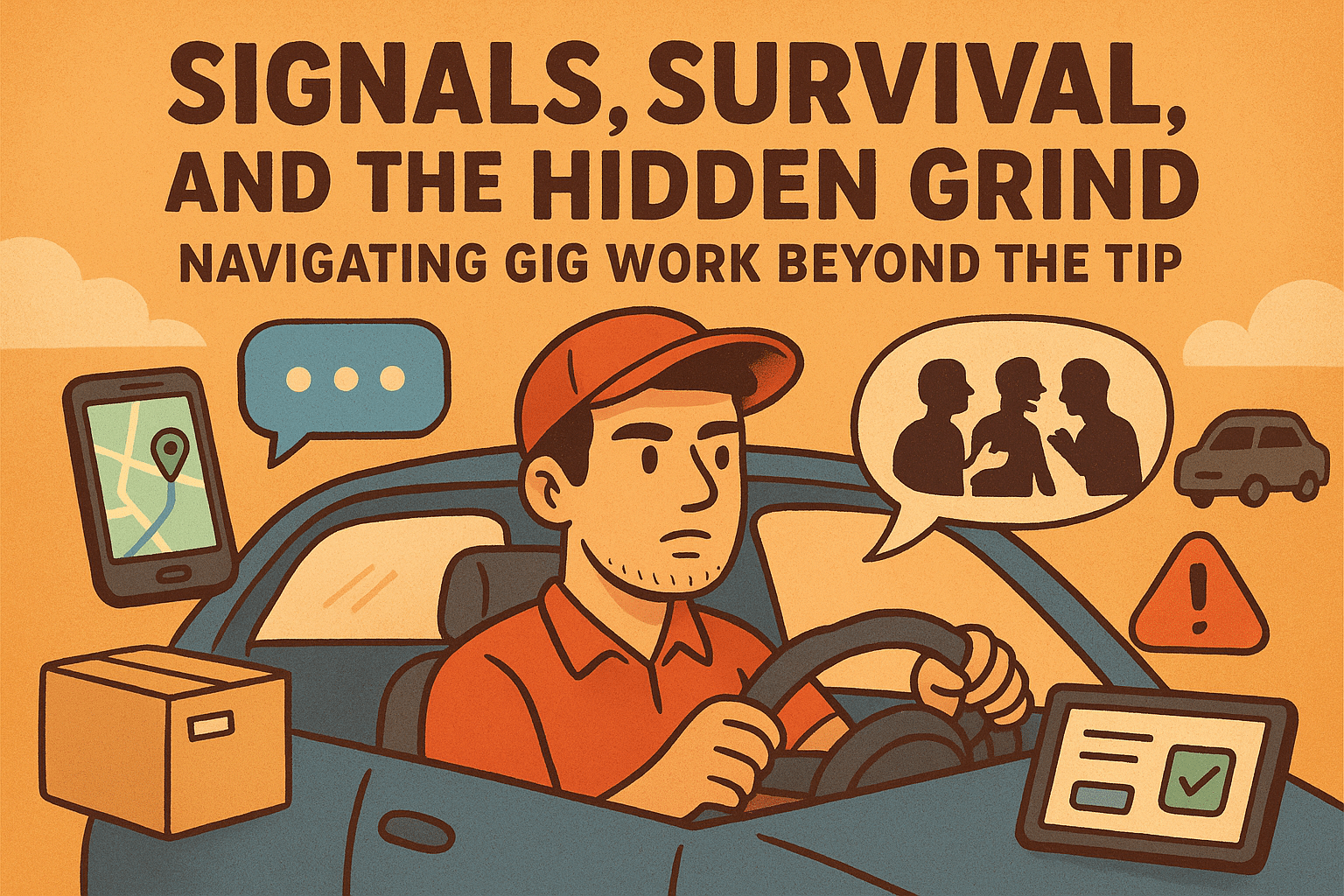
by Jason Tieri | Oct 4, 2025 | Blog
The conversation opens light—Halloween energy, audio gremlins, and shoutouts—but quickly gets to the heart of gig work: community and survival. We talk through why tight-knit groups like our Telegram chat matter in a market shaped by shifting policies, unpredictable demand, and platform opacity. Drivers need more than hustle; they need signal. In the group, people trade what’s popping in their city, which restaurants stall, whether a warehouse’s afternoon blocks run long, and what new tools are worth the download. It’s not just tips; it’s social proof and sanity checks. We’ve all arrived at a pickup where the tablet “never got the order,” or watched an ETA stretch while the meter doesn’t. Hearing how others handle a slow Tuesday or a surprise promotion turns the work from guesswork to pattern recognition. That’s the thread for everything that follows: when information is scarce, community fills the gap and reduces the risk tax you pay as an independent contractor.
From there, we dig into workflow and mindset—how behind-the-scenes processes shape the front-end grind. The most compelling content lately isn’t bravado on giant tips; it’s the back-office reality of tablets, routing screens, and restaurant batching logic. Seeing the merchant’s dashboard explains why your pickup jumps from “ready in 10” to “not in system.” Similarly, production stories—factory lines for diapers or the layered veneers inside theater seats—remind us how many invisible steps exist between raw inputs and a final product. Gig platforms are their own assembly lines, turning demand into payouts through algorithms that adapt faster than regulation. If you understand the hidden conveyor belt—how Amazon Flex counts block time, where DoorDash queues throttle—you cut waste and earn more. That’s the difference between waiting 15 minutes for a cold sandwich and flipping two orders in the same window.
Amazon Flex is a perfect example of where knowledge pays. A route spanning Spring Hill and Murfreesboro looks like 200 miles at a glance and feels unfair at $83. But the real calculus is block pay versus energy cost, unpaid deadhead after the last stop, and how many minutes you finish before the block ends. If your vehicle sips fuel—or better, you’re EV—you shift from per-mile fear to time arbitrage. Flex doesn’t pay return miles, so geographic spread matters, but so does your tolerance for rural pockets and lockbox delays. Many frustrations evaporate if you set a minimum hourly target and only book blocks that meet or beat it. And if you consistently draw long routes, ask whether it’s a station quirk, a specific start time, or a sorting issue. Flex can be profitable, but only if you treat it like logistics, not vibes: preload your charger map, avoid gas guzzlers, and carry a tight checklist for apartments, codes, and porch photos that reduce reattempts.
Policy and liability are no longer abstract; Lyft just sent New Jersey $19.4 million over misclassification assessments tied to unpaid unemployment and disability contributions. It’s a reminder that the ABC test in some states presumes you’re an employee unless all prongs say otherwise. Companies often settle without admitting employee status, but the money is real, and the precedent reshapes behavior. For drivers, the practical takeaway isn’t “W-2 tomorrow.” It’s knowing your ground truth: track miles, retain receipts, log wait times, and keep your filing clean. If states continue to enforce contributions retroactively, platforms will tweak pricing and incentives. That can mean more transparent per-minute rates, fewer arbitrary deactivations after customer disputes, or the opposite—harder acceptance metrics to contain costs. Your defense is meticulous recordkeeping and diversified income streams so policy shocks don’t sink your week.
Safety sits in the middle of all this. A clip where a delivery driver pepper-sprays a calm-looking dog sparks more than outrage; it surfaces the unwritten code of the doorstep. Homeowners should secure pets; drivers should pause, de-escalate, and ask for help before escalating force. Most dogs posture to protect territory; a slow step back and a clear request to the owner solves it. Pepper spray may violate platform rules and will almost certainly cost your account. The safest play: keep distance, never run, and use your voice. If a dog advances aggressively, then defend yourself. But act with prudence first. People love their pets, and the camera is always rolling.
On the opposite edge of the safety spectrum sit robots. Waymo reportedly passed a school bus with stop-arm deployed, then made an illegal U-turn near a DUI checkpoint in another clip. The questions are bigger than one mistake: who gets the ticket when there’s no driver, and how do we price harm when the operator is code? California will enable “autonomous vehicle noncompliance” notices sent to manufacturers starting July 2026, a start but not a deterrent if fines are trivial at corporate scale. The fi
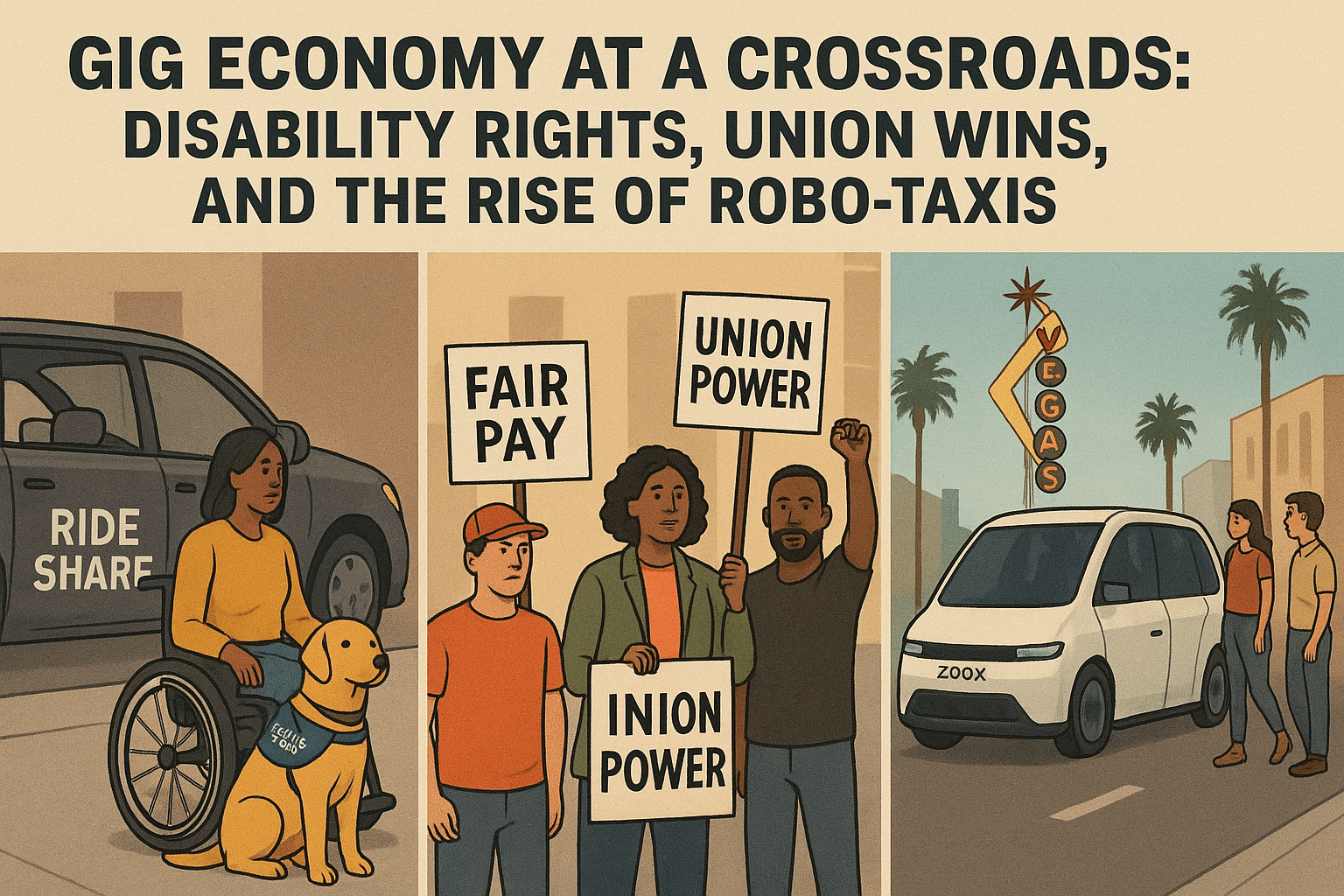
by Jason Tieri | Sep 22, 2025 | Blog
The transportation landscape continues to evolve rapidly, with recent developments highlighting both challenges and innovations in the gig economy. The Department of Justice has filed a lawsuit against Uber, alleging discrimination against riders with disabilities, particularly those with service animals and stowable wheelchairs. This raises important questions about the responsibilities of rideshare companies versus individual drivers who operate as independent contractors. The lawsuit claims that drivers have refused service, added inappropriate surcharges, and even verbally mistreated passengers with disabilities, despite Uber’s insistence that they provide adequate training and maintain a zero-tolerance policy for confirmed service denials.
This legal battle underscores the ongoing tension between gig worker autonomy and the need to ensure equal access to transportation services. While Uber maintains they’re doing their part through driver education and policies, the DOJ is seeking significant changes, including monetary damages and civil fines. For drivers, this raises practical questions about responsibilities when accommodating service animals or wheelchairs, especially in smaller vehicles where space is limited. The lawsuit highlights how the independent contractor model creates gray areas in service obligations under the Americans with Disabilities Act.
Meanwhile, Lyft has announced plans to save approximately $200 million from reduced insurance costs following their worker unionization deal in California. According to CEO David Risher, these savings will be passed back to drivers “in terms of better pay.” This represents a potentially positive development for drivers, though many remain skeptical based on past experiences with similar promises from rideshare companies. The California deal, which allows unionization in exchange for lower insurance requirements, demonstrates how policy changes can significantly impact the economics of rideshare services.
In the autonomous vehicle space, significant developments are unfolding in Las Vegas. Amazon’s Zoox has launched its distinctive robo-taxi service, offering free rides to several popular destinations. These purpose-built vehicles, which lack traditional steering wheels or brake pedals, can carry up to four passengers facing each other and currently travel routes up to three miles. After two years of testing with employees and their families, the service is now available to the general public through the Zoox app. Amazon plans to manufacture as many as 10,000 robo-taxis annually at their facility in California, signaling serious investment in this technology.
Simultaneously, videos have emerged showing people misusing Waymo autonomous vehicles, including performing stunts on them. These incidents highlight the challenges facing driverless technology as it becomes more prevalent, raising questions about security measures needed to protect these vehicles from vandalism and misuse. The novelty factor currently attracts attention that sometimes leads to problematic behavior, suggesting companies may need to implement deterrents or pursue legal action against those who damage or misuse their vehicles.
For gig workers, these developments represent both opportunities and challenges. The expansion of autonomous vehicles may eventually reduce traditional driving opportunities, but it could also create new roles in vehicle maintenance, customer service, or specialized transportation services that still require human assistance. The legal and regulatory landscape continues to evolve, with implications for how drivers must accommodate passengers with special needs and how companies structure their relationships with workers. As the industry navigates these changes, flexibility and adaptability remain essential for those making a living in the gig economy.

by Jason Tieri | Sep 13, 2025 | Blog
The gig economy continues to surprise us with bizarre incidents, ethical dilemmas, and evolving business models. In a recent episode of The Gig Economy Podcast, hosts discussed several noteworthy stories that highlight both the dangers and absurdities of delivery work.
One particularly alarming story involved an Uber Eats driver in Texas who detected something suspicious while delivering a package. Instead of completing the delivery, the driver went directly to the police station. Authorities discovered the package contained methamphetamine and THC cartridges cleverly hidden within baby wipes. The police then set up a sting operation, having the driver message the customer and claim he had broken down, requesting the customer come to an alternate location where police were waiting to make an arrest. This incident raises important questions about the responsibilities of gig workers when they suspect illegal activity.
In another shocking story, an Uber driver in Northern California demonstrated quick thinking and courage when faced with a dangerous situation. While transporting four teenage passengers, she noticed through her rearview mirror that one of them had a loaded rifle with a high-capacity magazine. Rather than panicking, she calmly created an excuse to stop at a nearby business. Once safely away from the vehicle, she asked someone to call 911. Police responded and detained all four passengers, arresting the 17-year-old who was already on juvenile probation. This story highlights the unexpected dangers gig workers can face and the importance of situational awareness.
The podcast also explored an ethical dilemma regarding a disabled DoorDash driver who couldn’t walk and therefore requested customers come to the car to retrieve their orders. This sparked considerable debate about accommodations, customer expectations, and whether certain disabilities might be incompatible with specific gig economy roles. While many supported the driver’s entrepreneurial spirit, others raised valid concerns about safety issues, particularly for female customers walking to a stranger’s car at night. The hosts suggested that other gig economy opportunities like Uber driving might be more suitable for someone with mobility limitations.
On a lighter note, the podcast featured amusing stories of package theft, including one where two thieves arrived simultaneously to steal an Amazon package and ended up fighting each other over it. Even more peculiar was footage of a bear stealing an Amazon package from someone’s porch, with the homeowner futilely shouting “No bear! No bear!” through her Ring doorbell before resigning with a defeated “damn it.”
The business side of the gig economy continues to evolve, with Waffle House announcing their entry into the delivery market. Their service will be powered exclusively by DoorDash Drive, operating from 9 PM to 8 AM. This development opens up new late-night delivery opportunities for drivers while giving customers access to Waffle House’s popular menu items without leaving home.
Additionally, the podcast touched on the ongoing development of autonomous vehicles, highlighting a Waymo vehicle that had mistakenly driven down a pedestrian path and gotten stuck at a barrier, unable to exit for approximately 20 minutes. While self-driving technology continues to advance, such incidents remind us that these systems still encounter unexpected challenges in navigating the complexities of real-world environments.
The gig economy landscape continues to transform with technological innovations, new business partnerships, and evolving worker and customer expectations. As these changes unfold, gig workers must remain adaptable, safety-conscious, and prepared for both the routine and the utterly unexpected aspects of their work.






